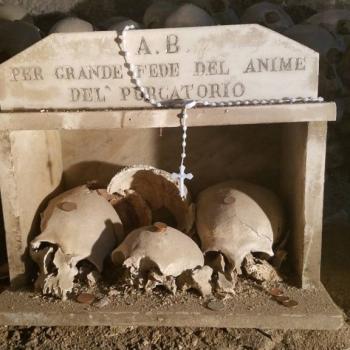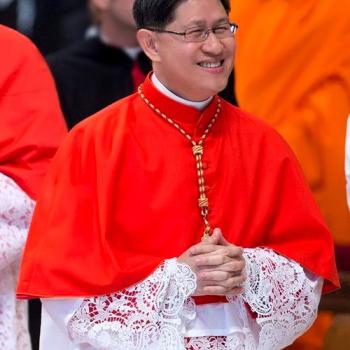Co-authored by Dr. Kate Kingsbury* and Dr. Andrew Chesnut

Those who aren’t Catholic or familiar with the largest branch of Christianity might be surprised to learn that unlike Protestantism which offers a single generic Baby Jesus, Catholicism posits myriad advocations of the Christ Child. And Mexico, home to the second largest Catholic population on the planet, is where some of the most unusual representations of the Holy Infant are to be found. In what follows I offer a brief description of the Christ Childs that will be included in my forthcoming book on the most intriguing Catholic and folk saints of Mexico and Guatemala.
Santo Niño de Atocha

The Holy Infant of Atocha is the oldest and by far most popular advocation of the Christ Child and is named for the district in Madrid where He originated and became revered for aiding Spanish Catholics who had been imprisoned by the Moorish occupiers. All the Spanish Catholic men in the city of Atocha were held captive by the Muslim Moors who permitted only young children to bring them water and food. Out of nowhere a mysterious little boy appeared with bountiful provisions for the captives. Local Catholics quickly discovered that the shoes on a statue of the Christ child at the local church were soiled and worn, which led them to believe that the mysterious boy was Christ Himself doing good deeds during the night when parishioners wouldn’t notice his absence from his station at the church.
In the New World, the Holy Child appeared in the Mexican state of Zacatecas in 1554, where he performed a miracle to aid trapped silver miners and over time became the patron saint of the northern state. As the patron of both prisoners and travelers, the Holy Child of Atocha is a natural for narcos, many of whom spend time in Mexican and American prisons and of course as traffickers in psychotropics they must travel frequently, as must their shipments.

A widely circulated photo of Ovidio Guzman, one of the sons of notorious narco kingpin El Chapo Guzman, wearing a pendant of the Holy Infant of Atocha reminded us that it’s not only Latin American folk saints who serve as narco-saints but also a number of Catholic ones. In October of 2019 the 28 year-old narco, who has taken on a leading role in the Sinaloa Cartel in his father’s stead, was briefly detained by Mexican security forces in Culiacan. Guzman’s arrest led to an immediate mobilization of cartel sicarios who took to the streets of the Culiacan to battle security forces in a brazen display of urban warfare. The overwhelming firepower of cartel gunmen and a simultaneous prison break led Mexican authorities to release Guzman within hours, a move that was widely criticized. President Andrés Manuel López Obrador, claimed he manumitted El Chapo’s son to avoid further bloodshed. Ovidio Guzman might well claim his pleas to the Holy Child had been heard.
Santo Niño Huachicolero

He only appeared six years ago but Mexico’s newest folk saint is already being condemned by the Catholic Church in Mexico as worse than Santa Muerte. The Holy Child of Huachicolero (Santo Niño Huachicolero) appeared out of nowhere on social media in 2016 and has caused such consternation that both the Archbishop of Puebla and more recently, the Archdiocese of Mexico have rebuked the surreal folk saint as worse than Santa Muerte because it’s ablasphemous distortion of the Christ Child Himself.
The anonymous creator(s) of the controversial folk saint slightly altered the image of the Holy Infant of Atocha, switching out his iconic staff and flowers for a gas can and siphon. Gas cans and siphons are tools of the trade for huachicoleros or gasoline thieves who look to the folk saint for protection from both law enforcement and pipeline explosions, such as a recent one in the state of Hidalgo that killed dozens, including children.
Veneration of the Holy Child of Huachicolero coincides with an escalating gas crisis in Mexico. In many parts of the country, from Guadalajara to Veracruz, there has been a shortage of gas at stations, with motorists unable to fill up their tanks. Some of Mexico’s most notorious cartels have ostensibly been involved in clandestinely peculating from pipelines that transport fuel. For thieves, this shortage has provided an opportunity, catering to people’s desperate need to acquire fuel at reasonable prices. They pilfer and sell gas and in turn are able to substantially supplement their meager income. petroleum out of desperation so that they can afford to keep driving their vehicles, transporting their families or merchandise as their needs require.
Gas thieves turn to the Holy Child of Huachicolero, propitiating him for protection from the police while they are out siphoning. They also supplicate Santo Niño Huachicolero to avoid fires and explosions in the places where they secretly store the fuel, and protect their families who may live close to, if not in that very same locale. They may also pray for protection of children who are often involved in pilfering activities. Children often take the role of juvenile sentinels who watch out for the police or other authorities whilst parents siphon and collect the fuel.
Holy Child of Raffles

Not even the initial shock of seeing the Holy Infant with a gas siphon in his hand prepared me for the sight of the Christ Child reclining his head on a hard human skull instead of a fluffy pillow. The childish innocence and doll-like cuteness of the Christ Child genre is retained here but unexpectedly juxtaposed with the most common memento mori – a human cranium. Catholics of course are most familiar with the death imagery of the adult Christ crucified on the Roman instrument of torture, the cross. But the Holy Infants of Prague and Atocha, among all the others, with their radiant countenance and baby fat evoke vibrant young life with no hint whatsoever of impending death and resurrection. So how to explain this unique Mexican advocation of the Christ Child in which the innocence of childhood is juxtaposed with the stark reality of death?
Let’s take a look at the origin story of the Holy Child of Raffles. In Mexico City in 1806 two priests were strolling through the district of Tlalpan when they suddenly heard the cry of a child. Disconcerted they began to look for the child and in a vacant lot discovered a small image of the Christ Child sleeping peacefully on top of a human skull. As they approached the strange image a natural spring gushed forth water and was subsequently baptized “the Eye of the Child” (el Ojo del Niño) currently located on the grounds of the Salesian seminary.
Thrilled by their discovery, the priests took the image to the archbishop who upon contemplating the Christ Child praised God for His mercy. At first the archbishop thought about giving the image to the nuns at a local monastery but after consulting with the city council he decided to hold a raffle in which God would choose the lucky recipient of the image of the Christ Child. The convent of Conceptionist Nuns of Saint Bernard won the raffle. However, cognizant that maintenance of the image could be a financial burden for the impoverished convent, the archbishop held a second raffle, which was again won by the Conceptionist sisters.
Convinced the Conceptionists couldn’t properly care for the miraculous image, the archbishop conducted a third drawing, this time without the name of the Conceptionists on a slip of paper. Not only did the lucky nuns win for a third time but had the name of their convent printed in gold, a sign from God which the archbishop could not ignore. The sisters were overwhelmed by the joy of winning such a gift from Heaven in the miraculous raffle to the extent that the Mother Superior decided to name the image el Santo Niño de las Suertes (Holy Child of Raffles). Since then the Conceptionist sisters have been the caretakers of the unique image and promoters of devotion to the Christ Child.
Since 2010 veneration of the Christ Child primarily takes place at his hangar-like shrine in the district of Xochimilco. While devotees petition the Holy Child of Raffles for miracles of all sorts, they seem to seek his divine assistance especially in three matters – health, fertility, and befitting of his origins, luck in the lottery. In fact, one of the highlights during his annual feast day celebration on the second Sunday of January is the raffling of an image of the Holy Infant to a lucky devotee.
Santo Niño Cieguito

The Holy Blind Child originated as a generic Christ Child though with bizarre emerald eyes cradled in the arms of a statue of the Virgen de la Misericordias (Virgin of Mercy) at a convent in Morelia, Michoacan. In August of 1744, a thief heard mass at the convent and afterward hid in the sanctuary with the intention to steal the valuable statue. The thief waited till around midnight, but when he neared the statue of Mary and Child “the evildoer heard deep in his conscience the cry of a child that seemed to come from the image of the child Jesus.” (1)
The thief muzzled the Christ Child’s mouth to stop His cries but, still feeling watched, he hastily threw the statue into his sack. He then took off on foot to a remote hiding place, but the Christ Child continued His cries. When he tried to remove the Niño’s emerald eyes, it shed tears of blood. When the authorities at the convent discovered the theft of the statue, they contacted law enforcement who were able to apprehend the thief and recover the pilfered statue. The thief admitted his crime and even related the miracle of the tears of blood.
The convent in Morelia sent the damaged statue to the Capuchin Convent in Puebla for restoration and protection where they opted not to replace the eyes, but rather leave His eye sockets empty to memorialize the miracle of the tears of blood. The statue was christened with the advocation of Santo Niño Cieguito, The Holy Blind Child, and embellished with the symbols of the passion of Christ, hair, a crown of thorns, a cross, and a tray with two eyes commemorating his desecration. Almost all the devotees I interviewed a few weeks ago at the Convent in Puebla spoke of miracles of healing with a couple specifically mentioning eye problems.
Santo Niño Doctor

Among the multiple advocations of the Christ Child in Mexico, el Niño Doctor stands out for his healing powers (Scheper Hughes2012). Traditionally, he is bedecked in an old-fashioned white physician’s smock, since Covid-19 the Child Doctor sports a modern medic’s turquoise outfit replete with scrub cap and a surgical mask covering his mouth. He is especially sought out for the healing of ailing Mexican children. In churches across the country, but especially at his shrine in Tepeaca, Puebla, his statues are often graced with offerings of toys, ex-votos for miracles of restored health that he is believed to have granted to the faithful.
His presence in Tepeaca dates back to 1942, when the mayor converted a part of City Hall into the hospital of the Guadalupe Castillo de Bautista. To staff the new hospital, the mayor sent four sisters from the Josefina congregation to serve as nurses. Among the nuns was was Carmen Barrios Báez, who brought with her a statuette of the Child Jesus. The image had been given to the nun by her parents, who had acquired it in Cuba. According to Barrios, on one occasion she found the niche that housed the little Christ empty.
She immediately notified the hospital staff, who began looking for him. As if it were a prank, minutes later the infant Jesus was already back in his niche with his shoes full of mud. At his shrine in Tepeaca there are scores of baby shoes left as offering by devotees who believe that the Holy Child Doctor constantly wears out his footwear as he travels far and wide attending to the infirm. Interviews with devotees at his Tepeaca shrine revealed, unsurprisingly that the great majority approach Him for miracles of healing.
*Dr. Kate Kingsbury obtained her doctorate in anthropology at the University of Oxford and is author of the forthcoming “Daughters of Death: The Female Followers of Santa Muerte” with Oxford University Press. Dr. Kingsbury is a lecturer and research associate at the University of British Columbia, Canada. Dr. Kingsbury is a staunch believer in equal rights and the power of education to ameliorate global disparities. She also works pro bono for a non profit organisation that aims to empower and educate girls in Uganda.













